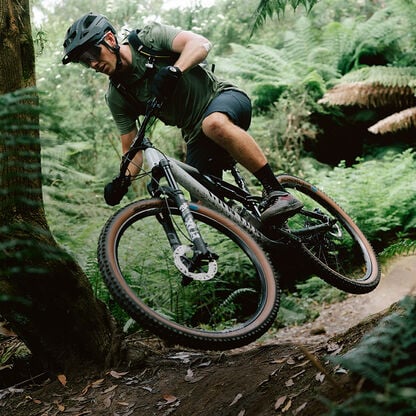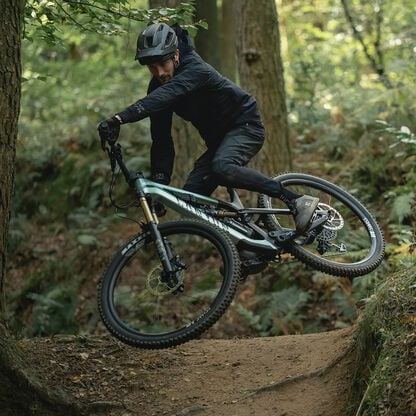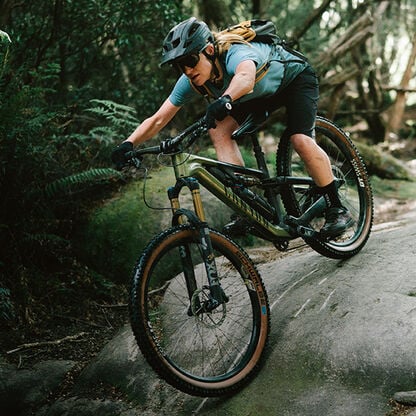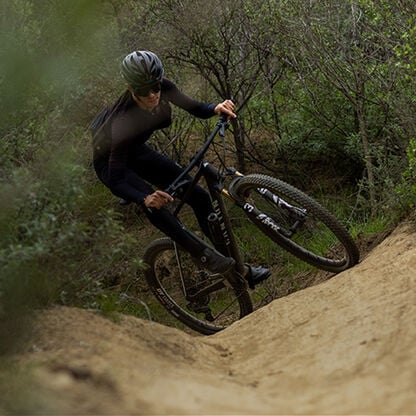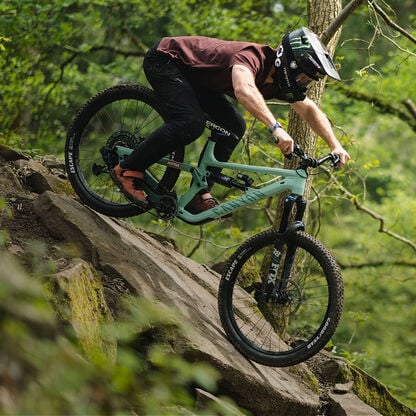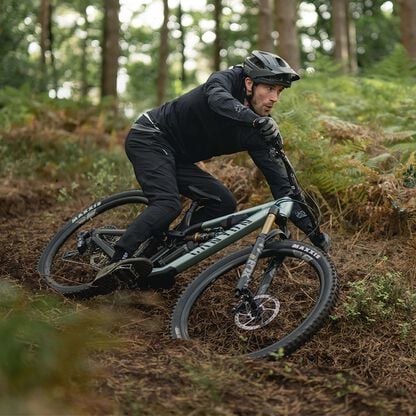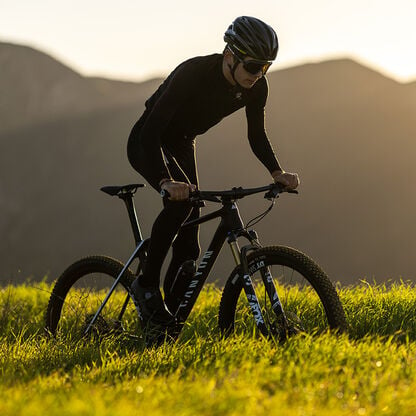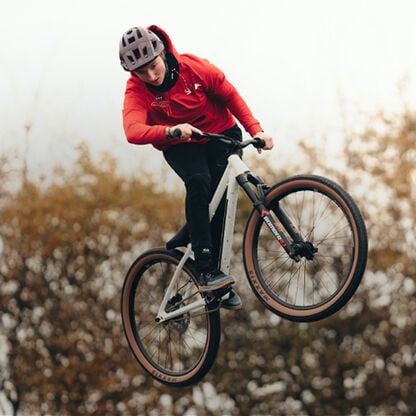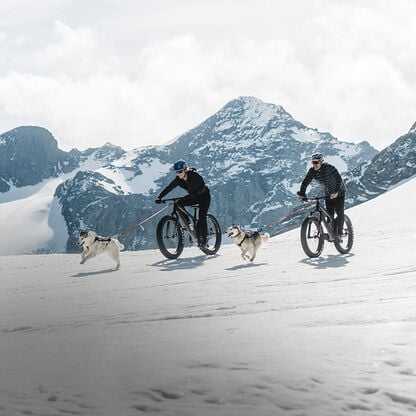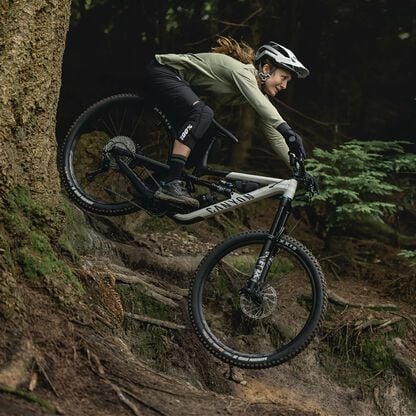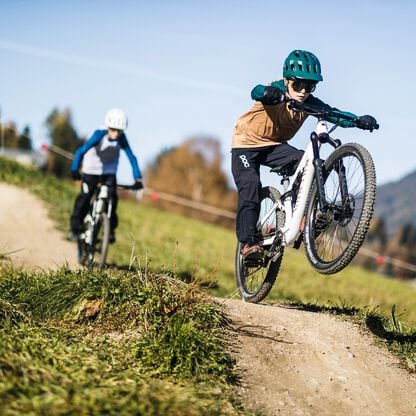Brake like a pro: Improve your mountain bike braking technique
Slow down quicker to go faster on your mountain bike. A guide to the basics of how to brake more effectively out on the trail.
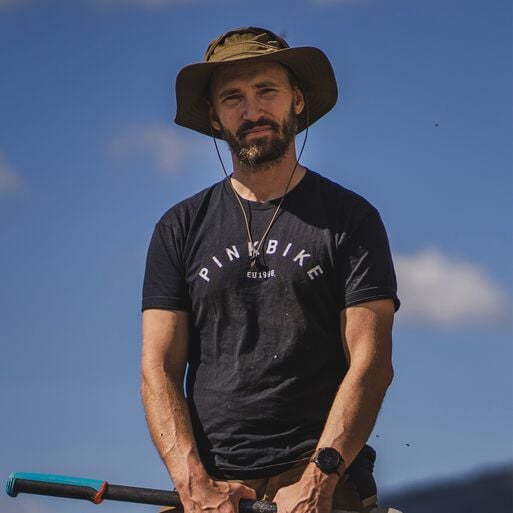

Contents
Watching elite mountain bike riders at full pace, they seem to brake far less than us mere humans. This is not true. Through years of practice and testing they have learned how to brake the right amount at the right moment to slow the bike down safely, and if you ask them they will probably tell you that they are still working on it.
It is maybe the most important skill in all of downhill racing, because as wild as they may look, winning mountain bike race races is all about control.
If you want to get faster on your mountain bike, you need to learn how to use your brakes effectively. This quick guide will help you learn how to start improving your mtb braking technique.
Getting to know your mountain bike brakes
Since they first appeared in the early 1990s, disc brakes have come to rule mountain biking. Every Canyon mountain bike comes with a pair of high performance, hydraulic disc brakes ready to perform. If you are coming from rim brakes, or cable-actuated discs, then this will be a big step up in terms of power and consistency. Too many collarbones have been broken by riders who are not cautious when moving to more powerful brakes. To avoid this risk, it is best to learn about your discs before you ride them into challenging situations.
This can be done anywhere, on the drive of your house, in the car park or in the streets where you live - you don’t need dedicated mountain bike trails to do this. The only thing you need is enough space to ride around a little. When you are rolling along at a comfortable speed, pull one brake lever progressively. By this we mean you should start pulling gently and gradually get firmer - what you want to avoid is pulling too hard too early - and see how it feels. Then repeat this for the other brake.
You will feel them begin to grab then lock the wheel. Try to do this a few times until you feel confident in how your brakes work. Try pulling the front, then the rear, rear then front and both. You want to understand how each brake feels and how they work together. If you grab the front brake too hard you may start to go over the handlebars (a great way to break your collarbone), pull the rear brake too hard and you will skid. These are both things you want to avoid out on the trail. This simple familiarisation technique can help you do that.
It is worth getting to know every set of brakes like this before you hit the trails with your mtb. Even if you are an experienced rider, different brands and models of brake, disc sizes and pad compounds have their own performance profiles and it is important to understand these fine differences before you find yourself in a demanding situation. For example, the SRAM Level brakes on the Exceed SLX will feel very different to the Shimano XTR brakes on the Strive CFR.
How mountain bike pros brake
It is tempting to think that the simple way to go faster on your MTB is to brake less. This does not work. Yes, you might get away with it a few times, but if you begin riding at a speed you can no longer control, it becomes a question of when you are going to crash, not if. Imagine a corner. Between the trail, your mountain bike and your riding skill there will be a limit to how much speed you can safely carry through this corner. If you are riding faster than this limit, it is easy to lose your line (or worse), which will lose more speed than if you came into the corner slower but held the good line.
Top mountain bike racers focus on their exit speed, because it does not matter how speed you have at the start or the middle of a corner, all that matters is how much speed you leave it with.

The golden rule of mountain bike braking
When you are braking, you should not be doing anything else, and neither should your bike. You want to aim to get your wheels in a straight line to avoid skidding. When you pull the brake lever a lot of things happen - your tyres’ contact with the ground changes, the suspension will compress and your weight will be pushed backwards. When that much is going on, adding extra things to think about is setting yourself up to fail. This means that you should not brake during a corner or when your wheels or are on a loose surface, for example.
Riding slowly, you can get away with poor technique like dragging your brakes through the corners, but as the speed goes up the risks and consequences get higher. If you learn to be consistent with your technique at low speeds, it starts to become a part of your riding and will hopefully be natural for you in difficult situations.
Braking on the trail
Keeping your eyes ahead on the trail is the core skill for mountain bike braking. If you can anticipate what is coming, you can plan for it. When you see something that you need to brake for, the first step is to come up into the ready position (Learn how to achieve the perfect position on your mountain bike for optimal control in our guide). This is important because hard braking causes big shifts in your weight, so you want to be out of the saddle to let your arms and legs soak up those changes.
The next step is to read the trail to plan your braking. If the trail is not too complicated, then all you need to do is judge when to pull the brakes to reduce your speed enough for the obstacle ahead. This is called the braking point. Elite mountain bikers, like Troy Brosnan for example, will repeat a trail many times in training, trying to perfect these braking points. They look to make them as short and efficient as possible until they find the limits of control.
When things get complicated
When the area where you want to be braking in has rocks, roots or other challenges in the way, you will need to plan your braking carefully to avoid them. Let’s say there is a big, wet root running right across your braking area. On wet roots, touching your brakes while your wheel is going over them is a sure way to slide out.
The temptation is to wait until after the root to brake, but if there is not enough space to bring your speed down safely before the obstacle, you will need to split your braking. You would begin braking before the root, release the brakes from a second as you go over the root before getting back on the brakes to finish your deceleration.
Repetition, repetition, repetition
Maybe all these points sound like a lot to take in? That is completely normal, braking is one of the most challenging mountain biking skills to master, and it becomes more and more complex the faster you ride. The best way to learn these techniques is to keep it simple. Try and apply them every time you ride, even if you are just nipping to the shops. By applying these techniques consistently in easy situations until they become second nature, you are building a skill so that when you do reach challenging situations you will be ready to handle them.

Wrap-up: Master your MTB braking skills
Good braking is maybe the most important mountain bike technique you can learn. It is the skill that will allow you to safely explore almost any trail - because if you can stop, you can stay safe. It takes time to learn these reflexes, to read the trail, to get ready for obstacles, but once they become second nature you will find yourself riding with more confidence than ever.
Discover our Mountain Bikes
Did this article help?
Thank you for your feedback
-
 About the author
About the authorMatt Wragg
Get to know Matt Wragg, the freelance photographer, writer, and self-proclaimed bicycle-breaker based in Nice, France. Despite unsuccessful attempts at XC, trials, 4X, and DH racing, Matt's passion for mountain biking never waned. After a stint in communications consulting, he decided to pursue his love for cycling and moved to New Zealand. Since then, he has traveled the world, chasing trails and building a successful career as a cycling photographer and writer. In 2021, he was diagnosed as autistic and has been coming to terms with it. His bike cellar is a true testament to his love for cycling, housing bikes that range from freeride to cargo.
